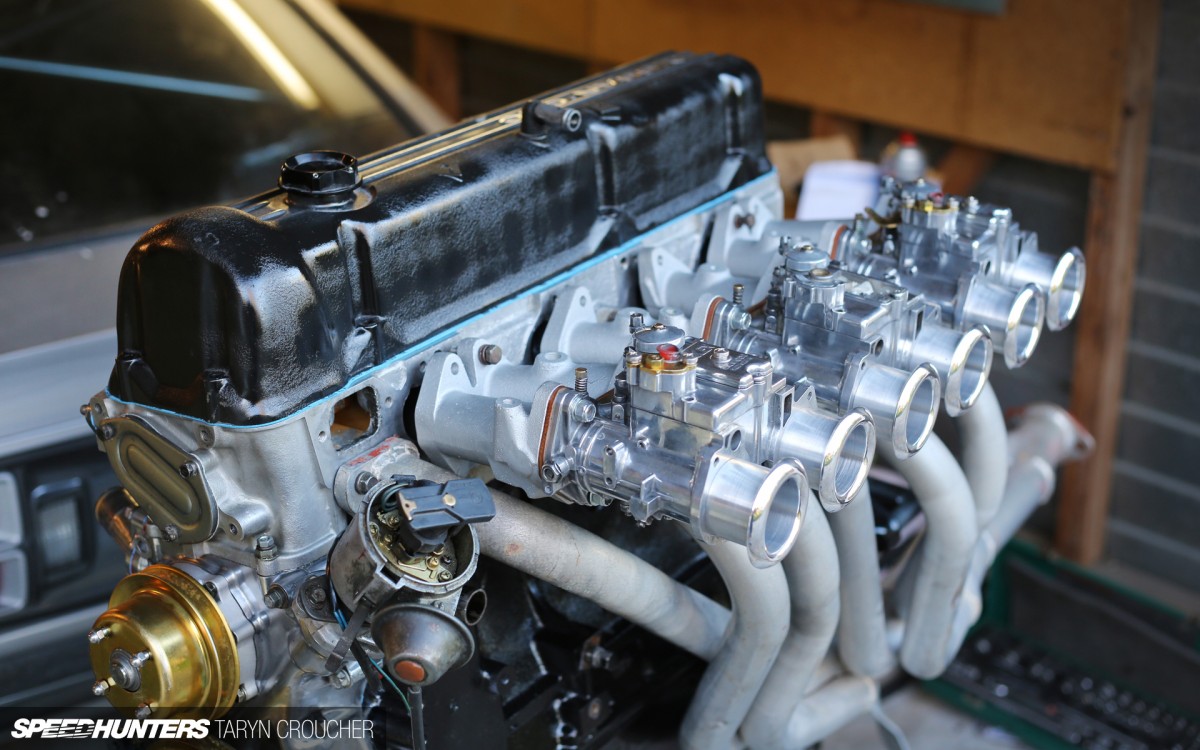
It’s easy to think of Aston Martin as a big factory team. Expensive, bespoke sportscars, seen competing on the global stage against Audi, Toyota and Peugeot at Le Mans or Ferrari and Porsche in international GT series. Corporate might against corporate might. But think again. Consider just how many cars these other firms produce in comparison: Ferrari produce three times as many cars and sit under the protective umbrella of the Fiat group. Porsche? 30 times as many cars.
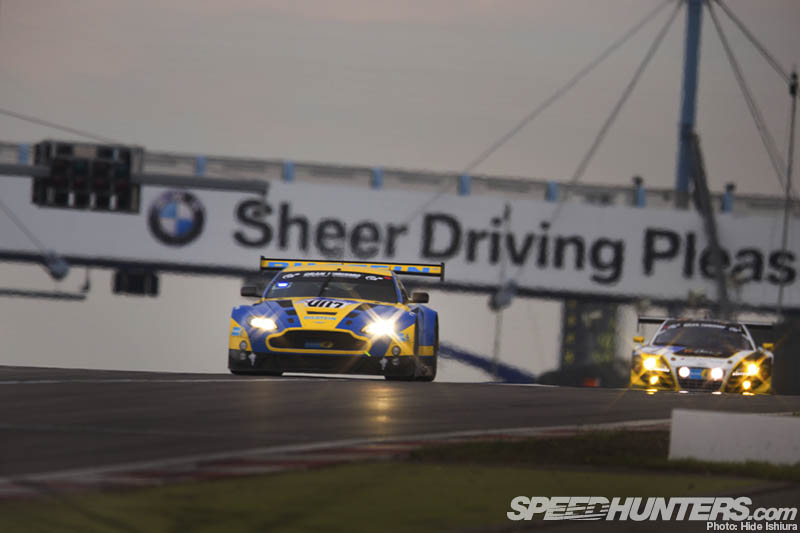
Would underdog be too strong a term to use? Certainly not when you look at their opposition in a race like the Nürburgring 24 Hours. This is home territory for Mercedes-Benz, Audi, BMW and Porsche, who turn up with F1-style hospitality units to ram home the message. One Aston Martin GT3 against the 28-strong domestic juggernaut, joined only by singleton entries from McLaren and Nissan; Aston Martin are a team seriously punching above their weight, and yet still they often knock their opponents off their feet.
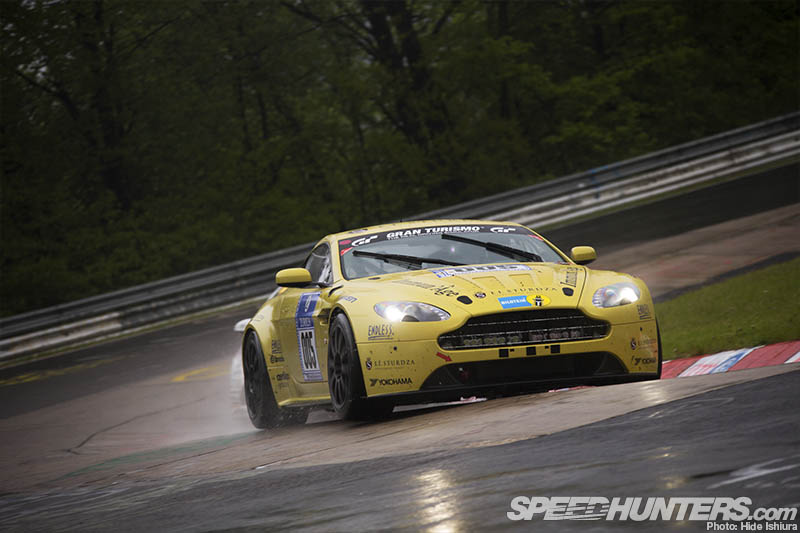
The factory entered four cars at this year’s Nürburgring 24 Hours, continuing an unbroken line of participation that started in 2006, but which has roots right back to the 1950s. Aston Martin have serious heritage at the Nürburgring: in 1957 the DBR1/2 took victory in the 1,000km, then Stirling Moss won in a DBR1/3 in ’58 and the next year Aston won both the Le Mans 24 Hours and the Nürburgring 1,000km.

In the modern era, Aston Martin officially entered the 24 Hours in 2006 following the launch of the V8 Vantage; Aston Martin CEO Dr Ulrich Bez showed personal commitment by racing a Vantage himself, finishing 24th overall. A class victory followed in 2008, again with Bez on the crew; in 2009 class victory in SP8 with a V12 Vantage (yes, with the CEO again driving); in 2011 a pair of Zagato concepts were raced; and in 2012 Bez raced another Zagato alongside two top class SP9 Vantage GT3s. Aston Martin have had a 100 percent finishing rate since 2006: something that in 2013 they wanted to keep up.
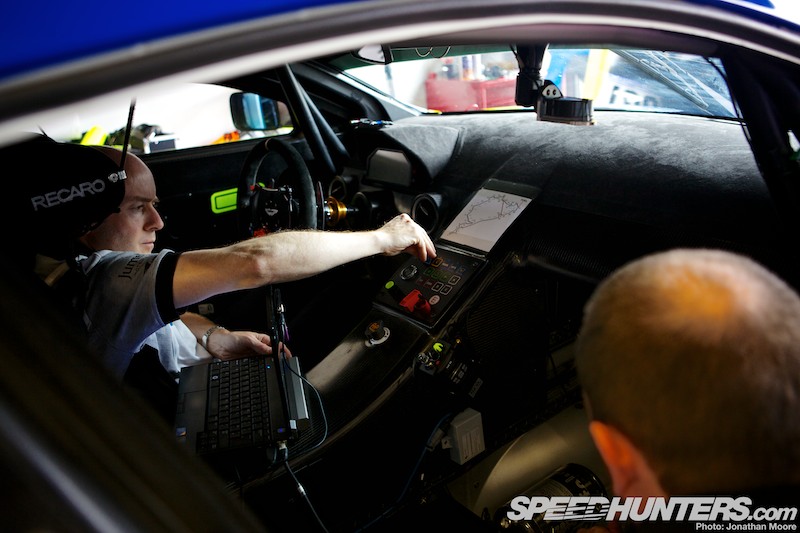
The company have a technical base in the industrial area just off the Döttinger Höhe straight, next to several other automotive firms, from which they run their test fleet. Year round, Aston use the Nordschleife as a proving ground for their road cars, but this weekend would be all about racing.

For 2013 the focus of the team would be the #007 Vantage GT3: 600hp and 700nm from its six-litre V12. The stunning Bilstein livery sat well on the car – though likely less well with the Phoenix Audi team which carried that sponsorship to the win in 2012. Bilstein are a primary technical partner of Aston Martin, supplying dampers for all AM road cars – they’re a firm who describe the Nordschleife as their ‘living room’, so were as up for a fight at the N24 as anyone.
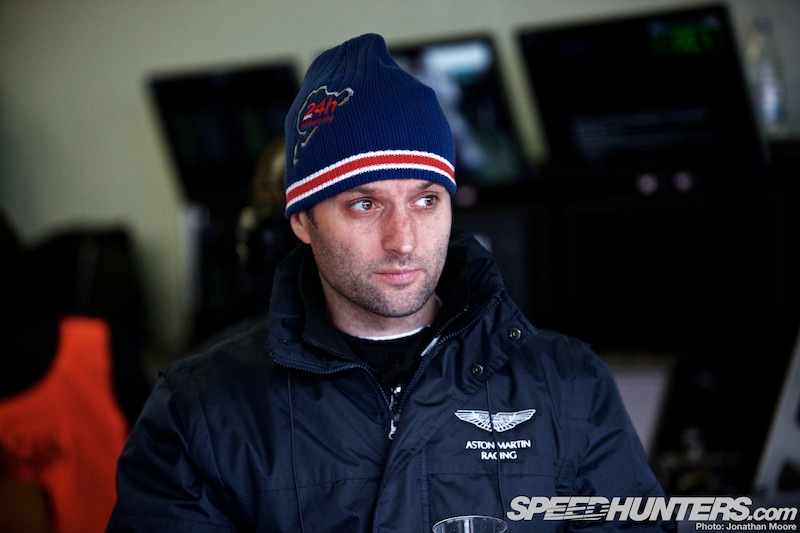
#007 had competed in two VLN races on the Nordschleife to warm up for the main event, and for the 24 itself the team pulled no punches. The driver roster was a statement of intent, with four top-line pros on the crew: Darren Turner, Stefan Mücke, Allan Simonsen and Pedro Lamy. But that would be the only way to take on the local specialists and might of the domestic factory teams.
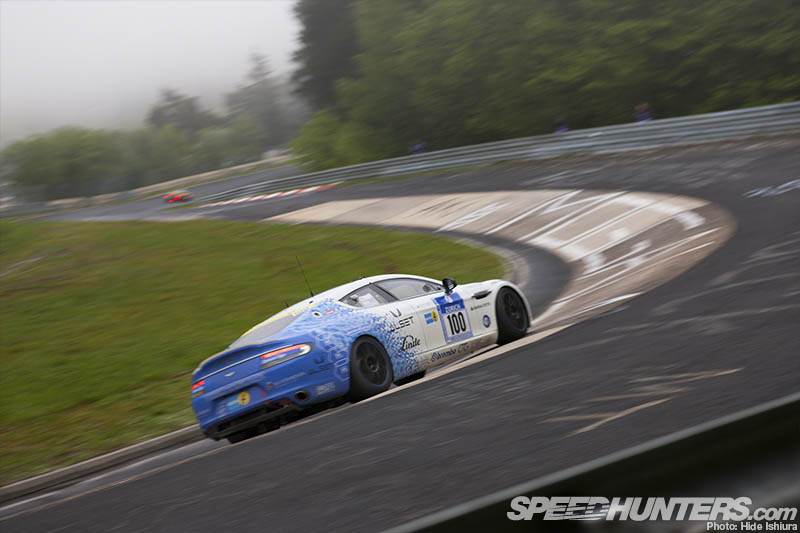
AM’s second car was running in the invitation experimental class, E1-XP2. The big four-door Rapide model had history at the N24, as one was entered in 2010 and took a class podium finish, but the S competing in 2013 was a different proposition altogether. #100 would be the first ever hydrogen-powered car to compete in an international event and also the first zero emissions car to complete a race lap on the Nordschleife. That’s right – an eco-friendly racing lap!
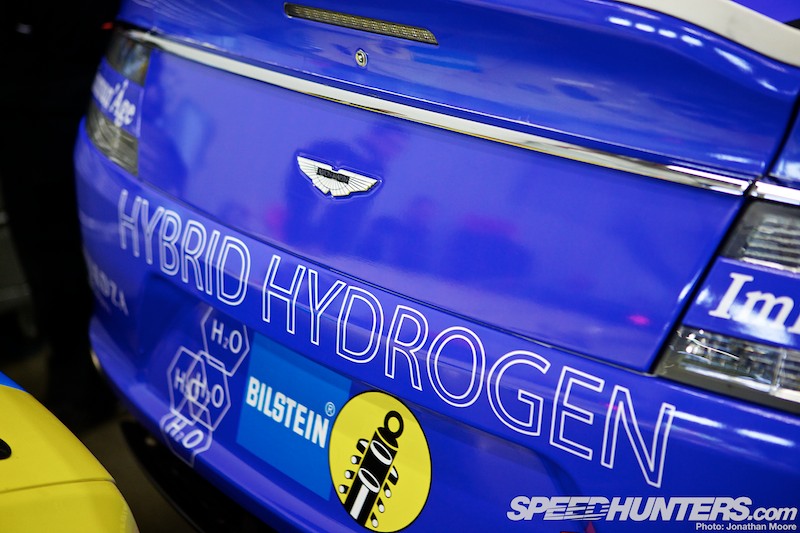
The standard six-litre V12 prototype was bolstered by a pair of small turbochargers, with the compression reduced from 11.5:1 to 9.5:1 to compensate. The system added about 100kg overall to the base weight, with four fuel cells added: two next to the driver and two in the trunk, holding 3.2kg of hydrogen – equivalent to 12 litres of gas. The engine could run on pure gasoline, pure hydrogen or a mix of both, controlled by the driver from the cockpit; the Rapide’s ECU would control fuel compounding, injecting gas into the hydrogen to provide a power boost.

Pressurised hydrogen refuelling would be carried out at a separate stand at pit entry: from there the car would continue down the pit lane to garage 28 for any regular refuelling, driver changes or maintenance. From the outside the car looked pretty standard, with just the addition of small scoops either side of the grille for the intercoolers. It’s amazing how a car this big could still look so svelte and racy. And green at the same time!
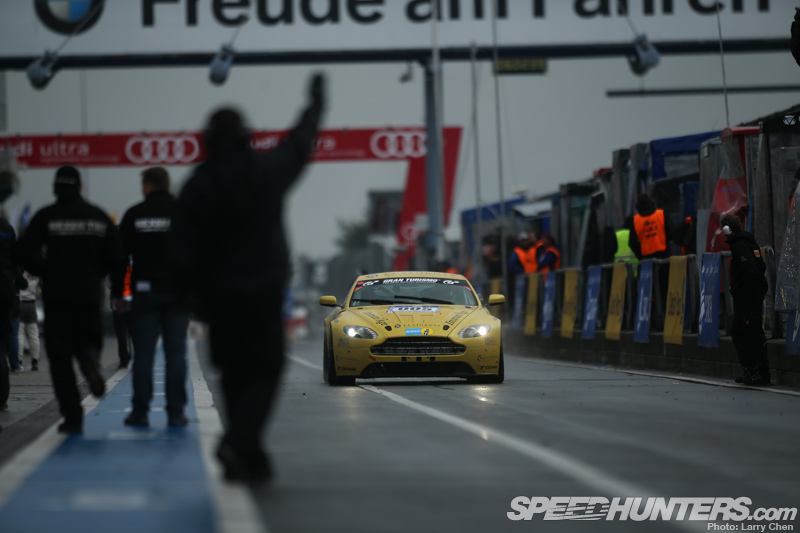
Two more Vantages bolstered the AM entry, under the Aston Martin Test Centre banner: #05 was a V12 Vantage running in the SP8 class. The six-litre V12 car was in close-to-production specification – a customer Vantage also ran in the same class.
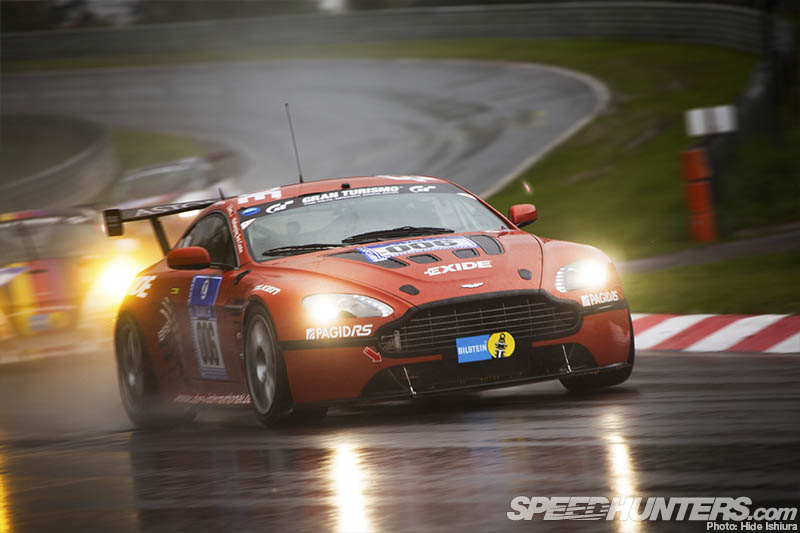
The #006 V8 Vantage GT4 had previous history at the N24: this car had the nickname ‘Smurf’ from when it had run at the N24 in a blue paint job, and would be driven by AM customers. They were all handy pedallers: for instance, Mal Rose was a veteran 24-hour gentleman driver. He’d competed in the N24 several times, as well as the Bathurst 12 and Dubai 24 in his fire-spitting Donut King-livered Holden Commodore.
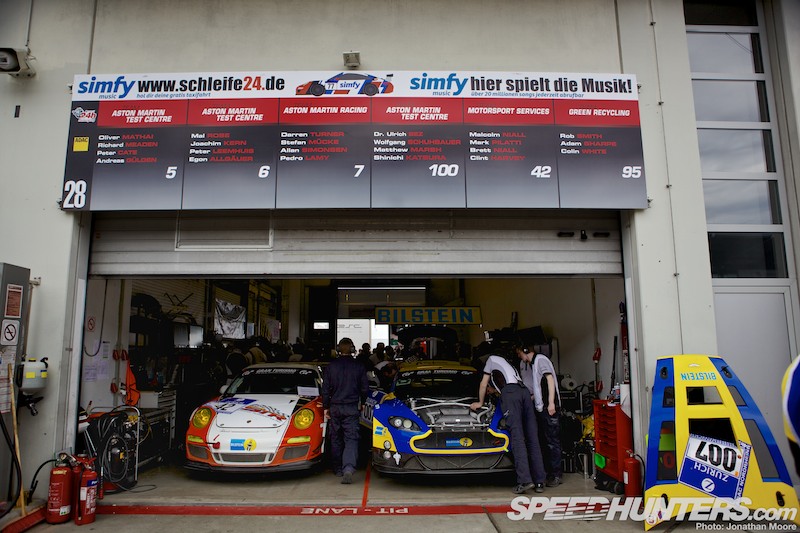
If there’s one thing that racing at the Nürburgring 24 Hours does, it’s that it brings everyone down to earth. With over 170 cars crammed into a pit lane made for 34, teams operate in conditions that would make F1 mechanics, used to acres of space and hospital conditions, collapse into tearful heaps.
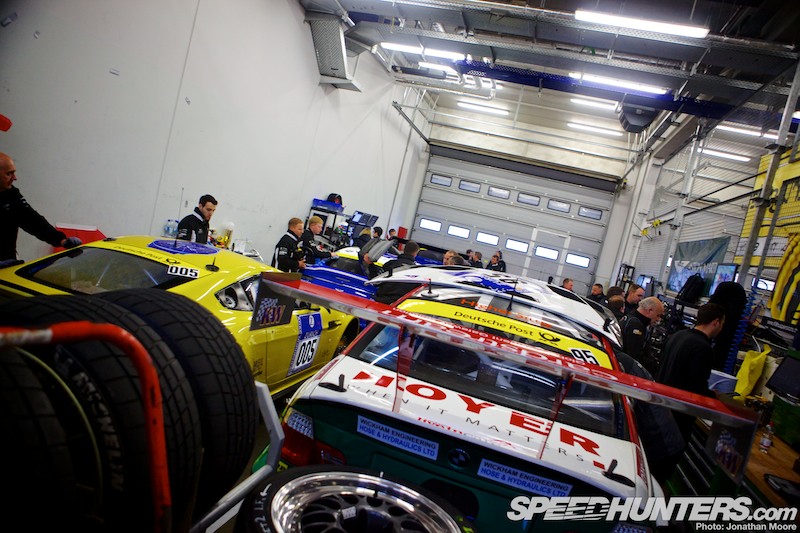
AM’s pit box, #28, would not only have their four charges squeezed in but also a Porsche 997 and BMW M3 GTR for good measure. Six cars with barely room for one person to fit in between; 30-odd mechanics and crew all trying to work around each other and prep their cars – with media and guests getting in the way. It’s an incredible thing to witness. And this is even before the race starts.
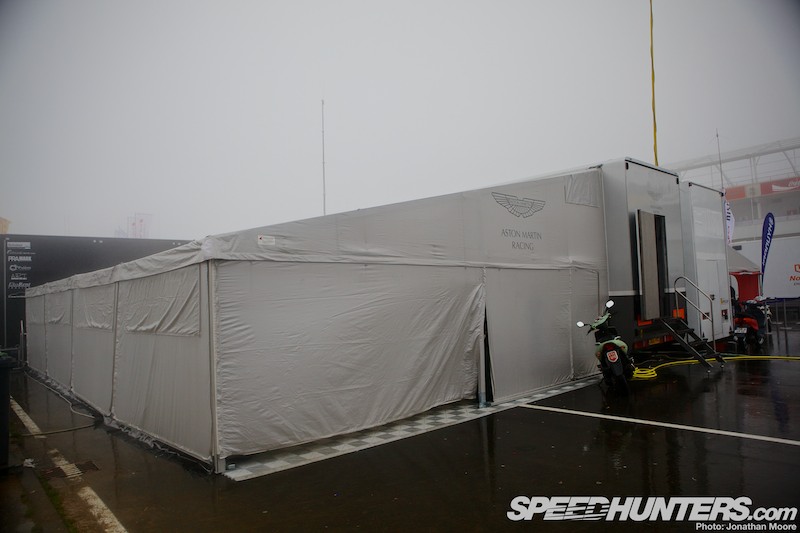
The day before the race, the forecast didn’t look good and was likely to get worse. The opening days were spent setting up the race truck and single awning that the team would operate from – that at least provided a little bit more space than the garage.
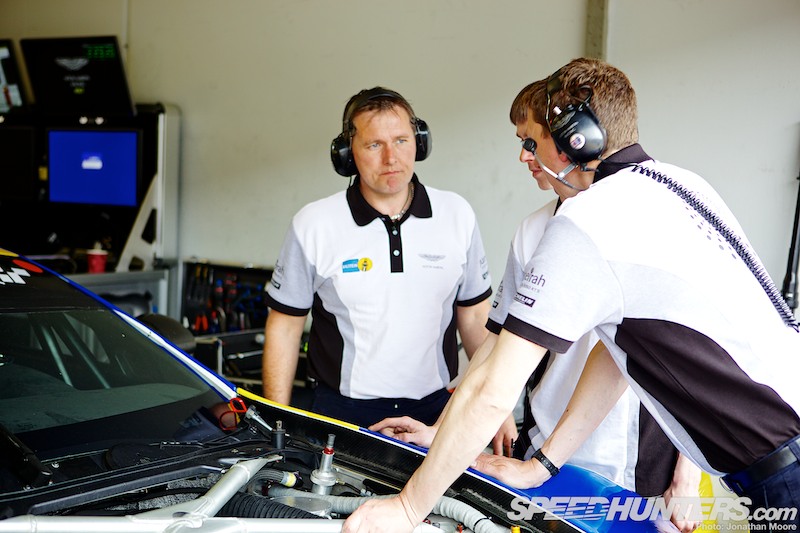
The garage itself would be reserved for data monitoring kit, basic maintenance and spares, hanging off every spare bit of wall space or hung off the wire dividers, whilst at least with #007 at the front of their three-car column the team had a little more space to work with.
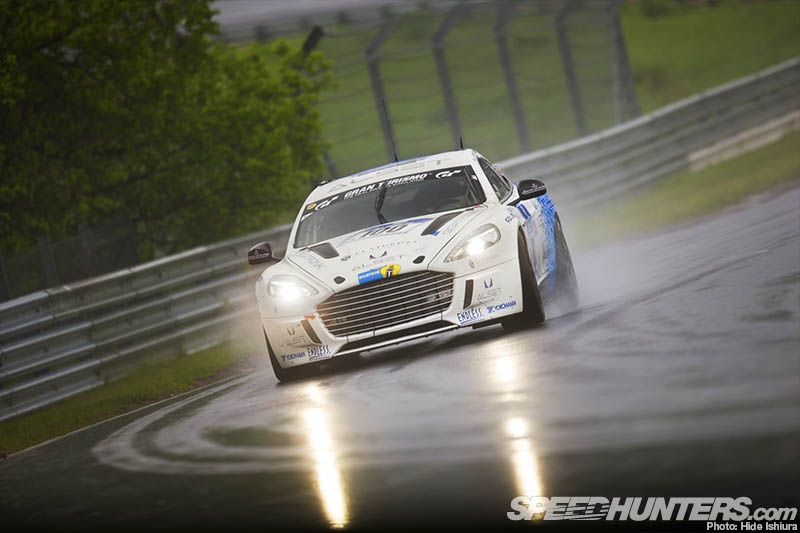
The first two-hour practice session for the 24-hour runners was planned for Friday afternoon, but already the schedule had begun to slip because of the appalling weather: fog hung over the track reducing visibility to virtually nothing, and the F3 single-seaters had their session cancelled – even though they would only be running on the GP track and not venturing into the forest. However, after the fog lifted the Classic 24 cars splashed around for a bit, and then the Astons and their 172 opponents took to the track for a delayed practice – the #100 Rapide heading out to notch up its first competitive laps.
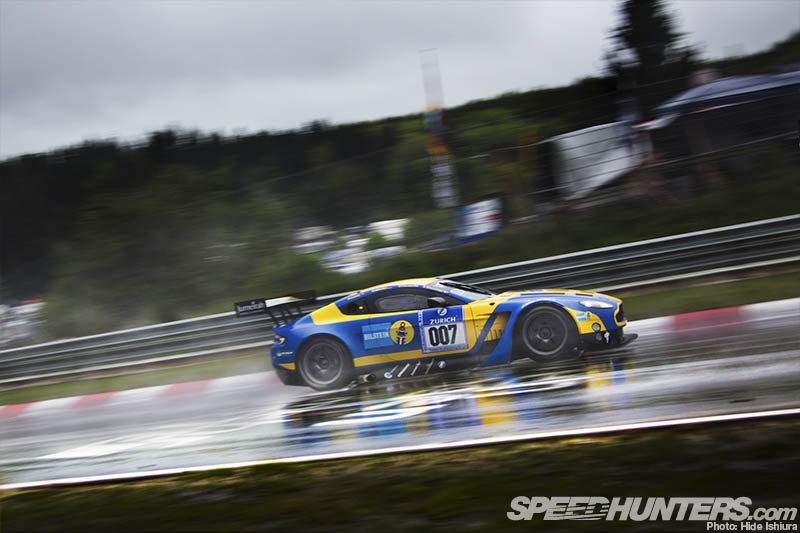
#007 went out with Stefan Mücke at the wheel – the heavy rain continued on and off through the two hours, making the time more about adapting to the conditions and optimising the car for the expected wet race. Therefore #007 completed the session in 31st place overall, over a minute off the fastest Mercedes-Benz SLS, and just 10 seconds ahead of #005.
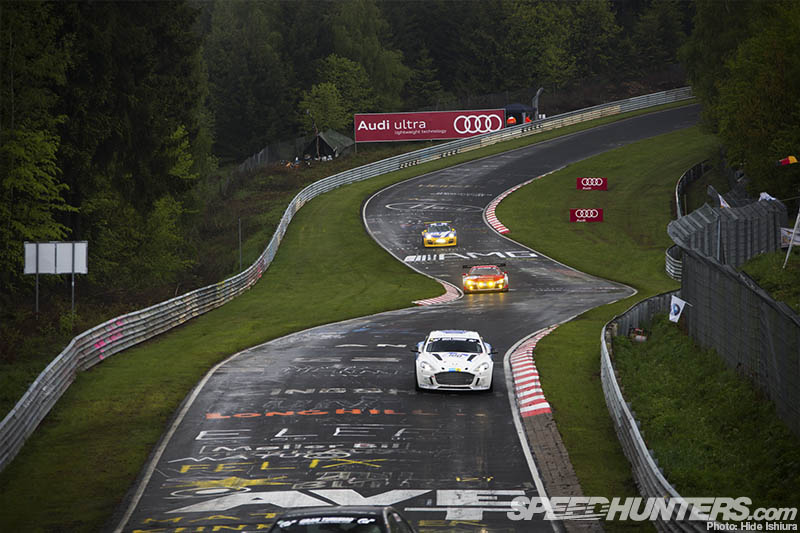
Similarly, the long evening qualifying session that kicked off at 19:35 would be about set-up; four hours of running through a gloomy dusk and into the dark. The time to focus on times would be Saturday morning’s Q2, when the weather was expected to be sunny and dry. During Q1 the rain eased but the fog rolled back in, although the track did dry, and at 20:51 Dr Ulrich Bez went out to complete a qualifying lap using just hydrogen. When the flag dropped at 23:35, #007 had put in nine laps in total, with the other three works cars only putting in a couple more than that.
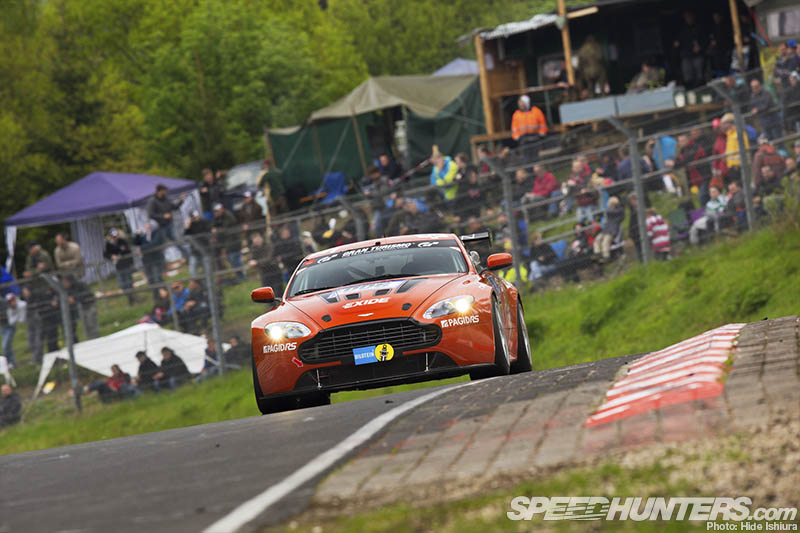
So on to the second qualifying session. A strange yellow orb shone in the sky above the track. What was this bizarre object? It would be the only sun we’d see over the weekend… At 11:20 the track went green, and the first cars took to the dry track.
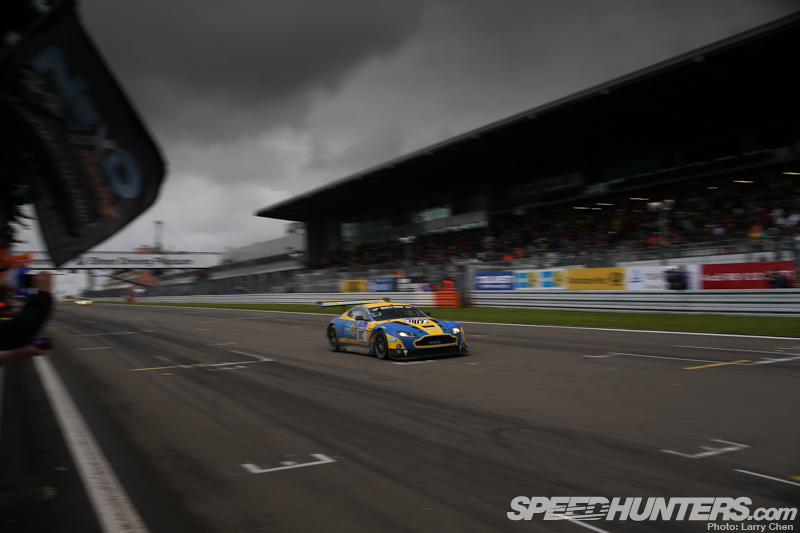
The key here still wasn’t to chase the overall fastest time, but to ensure that #007 made it through to the Top 40 Qualifying run-off. By the end of the two hours #007 was appropriately in seventh, easily in the shoot-out and within two seconds of the fastest SLS. In fact, just 10.5 seconds covered the entire top 40. #005 was sixth in class after being held up by traffic; a disappointment after topping the previous evening’s session.
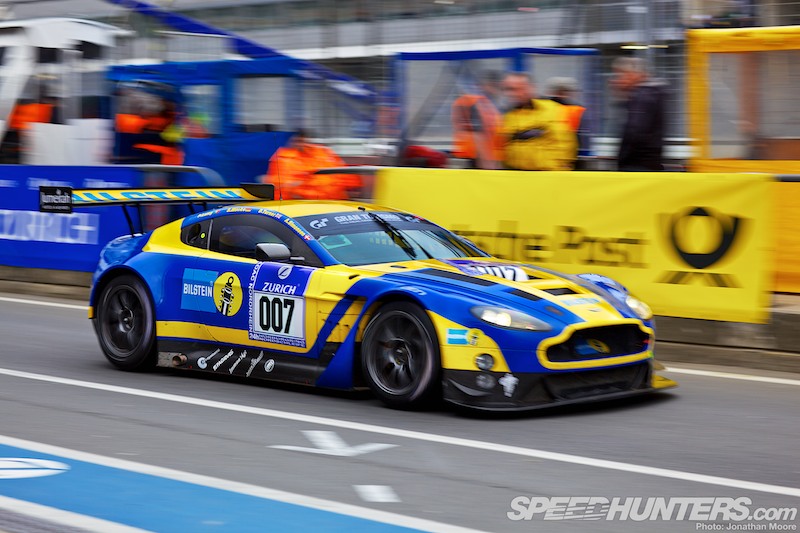
At 18:50 the running order for the shoot-out had been drawn: Pedro Lamy would be the second car out, taking #007 out for its two flying laps behind the #12 Manthey Porsche.
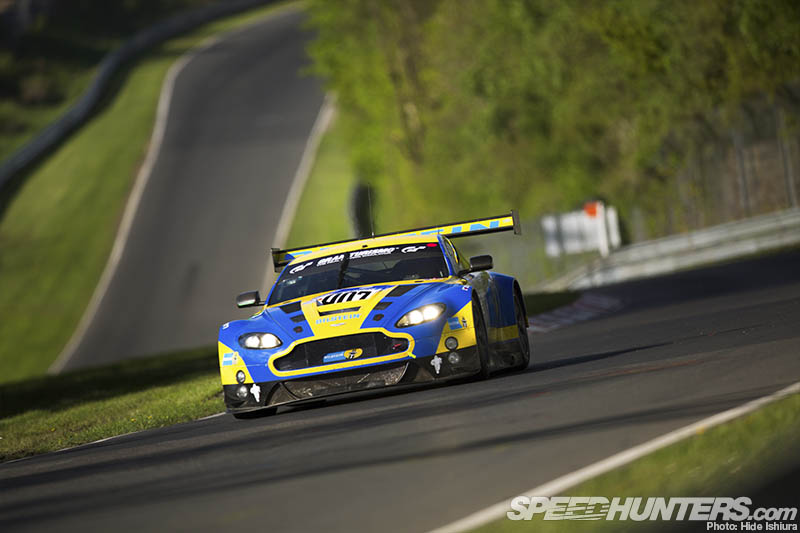
On the out-lap around the Nordschleife, Pedro caught and passed the Porsche ahead to ensure a clean set of flying laps; something that other cars would try and do on the fast laps themselves, often ruining their runs.

His first lap was a 8m21.748s, placing him seventh (that number again), but his second tour was even faster: an 8:18.362s and fastest overall. The team kept their fingers crossed as the following cars crossed the line one after the other – but pole was snatched away as the Phoenix Audi R8 LMS Ultra put in a lap over a second faster. That needle about losing Bilstein sponsorship perhaps making them put in that extra effort to keep the Vantage off pole…
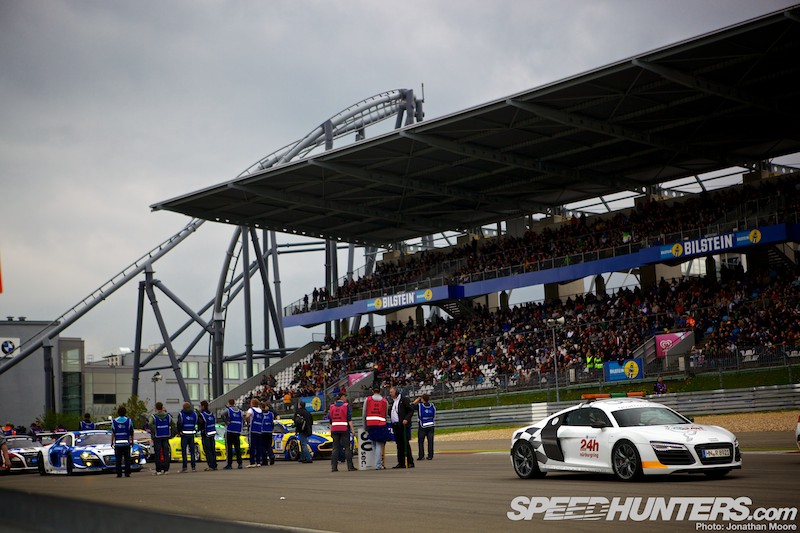
There was then almost a day’s gap until the race start at 5pm on Sunday; a long wait for all involved that was invariably spent watching the clouds roll in over the track. By 16:30 the 176 starters were packed along the entire length of the start straight and the grandstands overlooking the track were full to the rafters.
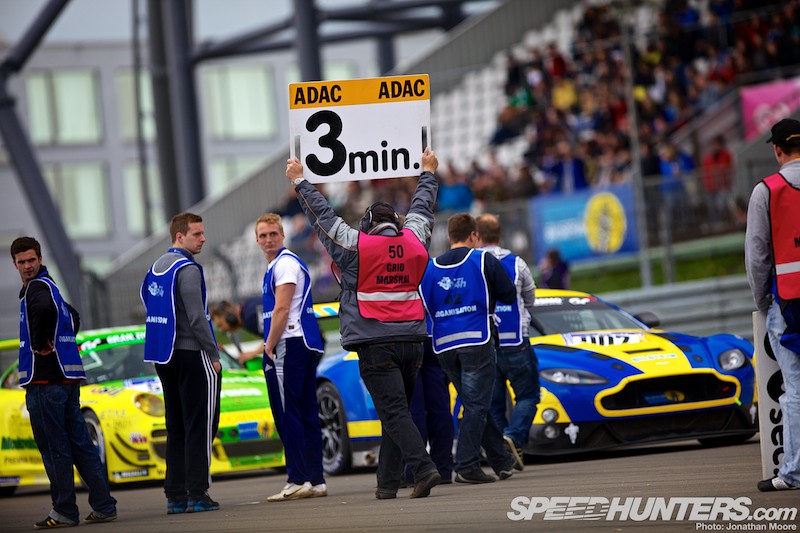
The noise dropped to an expectant buzz as the start approached. With 15 minutes to go the cars took off from the grid to start their formation lap and the long wait began for the teams in the pits, the fans in the tribunes and the marshals and photographers by the side of the track.
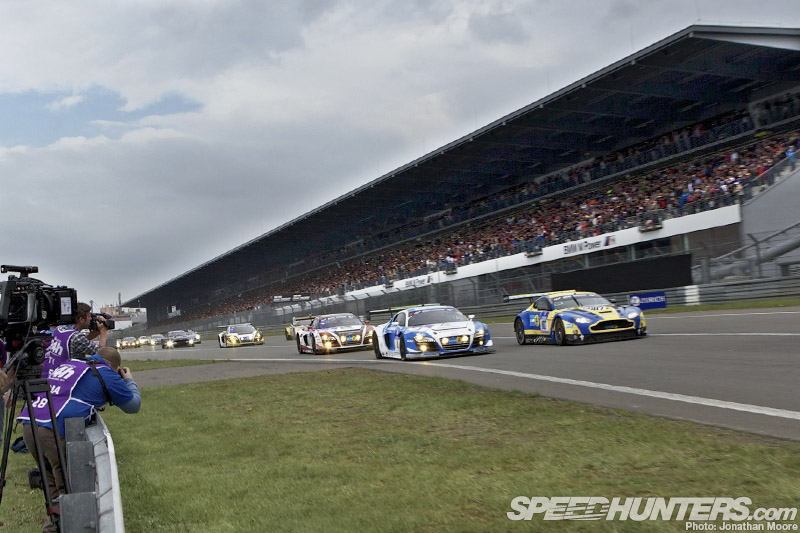
As 5pm ticked round, the noise of the leading start group could be heard, and in the distance the safety car pulled off: the Phoenix Audi took over the pace as the field roared towards the start-light gantry.
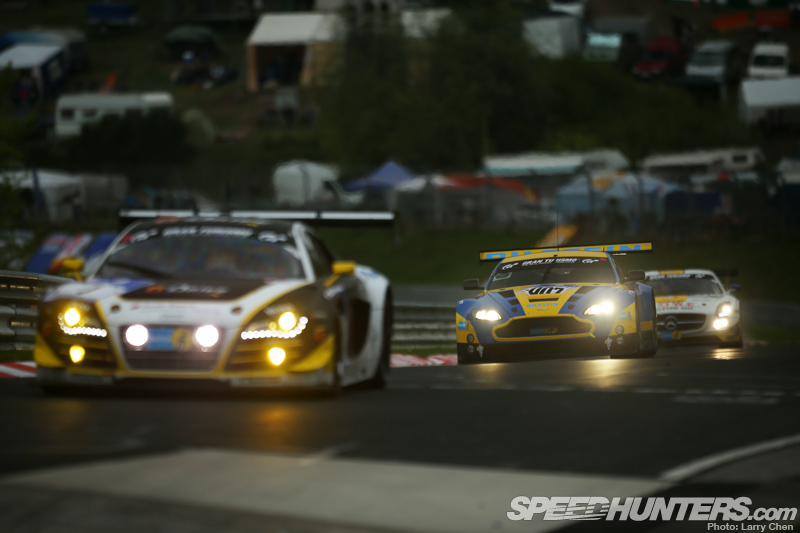
The pace of the Aston Martin proved to be anything but a flash in the pan: Pedro refused the let the Phoenix Audi break away, and by 20 minutes in had worked his way up to the tail of the R8, harrying the Audi all the way round the Nordschleife for lap after lap.
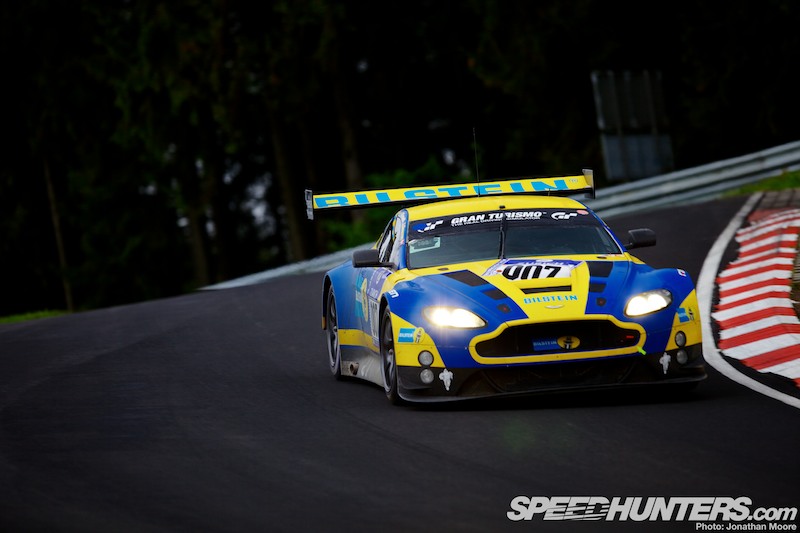
Within a couple of laps traffic was already a problem: Pedro was baulked by a back marker and dropped back slightly, only to bounce back with a fastest lap that was 2.5 seconds quicker than the Audi ahead.
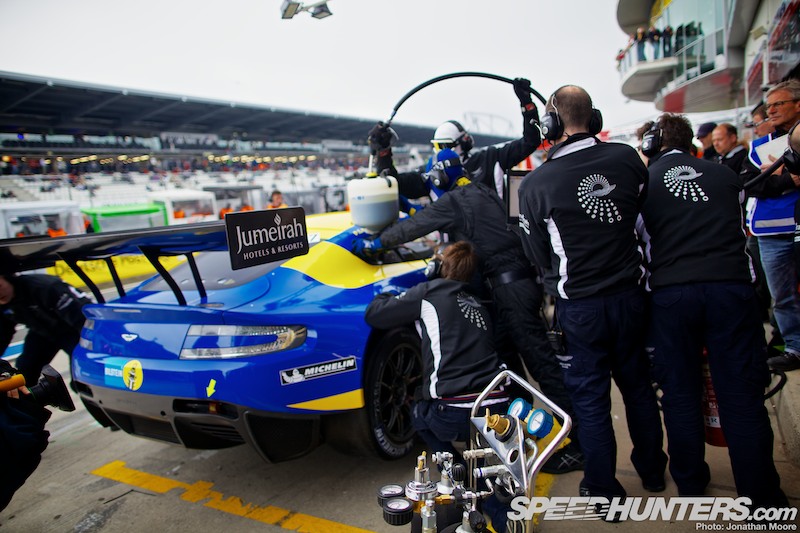
The first stops were taken early, after most cars started light on fuel.
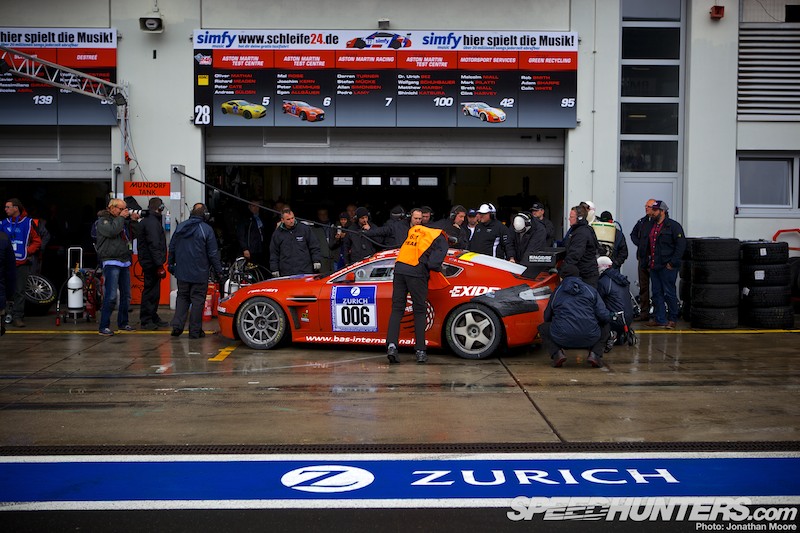
With the packed pit lane, stops had to be carefully planned in conjunction with cars in same and neighbouring garages: a single car took up the entire garage width, so if multiple cars stopped they had to angle in and stop where they could.
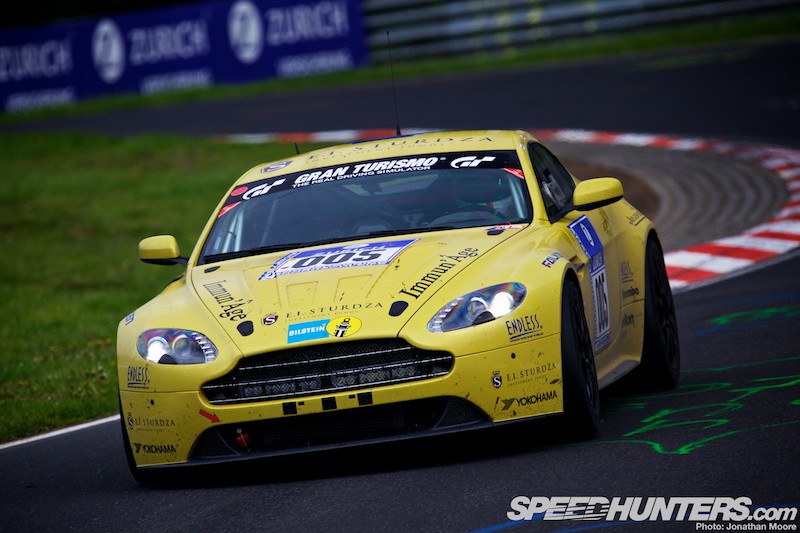
By 6pm #005 was up 11 places and eighth in class…
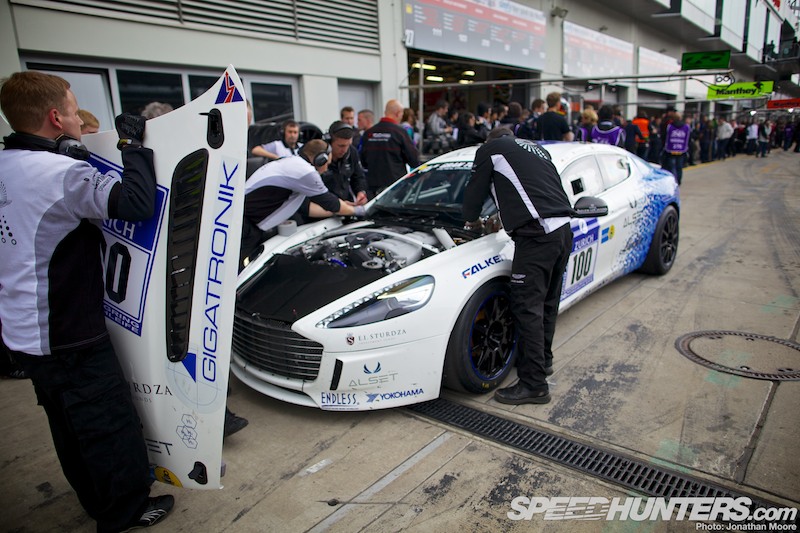
… though the steady pace of the Rapide was countered with a problem at its first stop: a thing as simple as the bonnet mounting pins caused several minutes delay. The Rapide would be tanking up on hydrogen at pit-in, and during the race the team would work on reducing the filling time. But at 18:37 the Rapide chalked up another first: the first ever race laps for a race car using pure hydrogen.
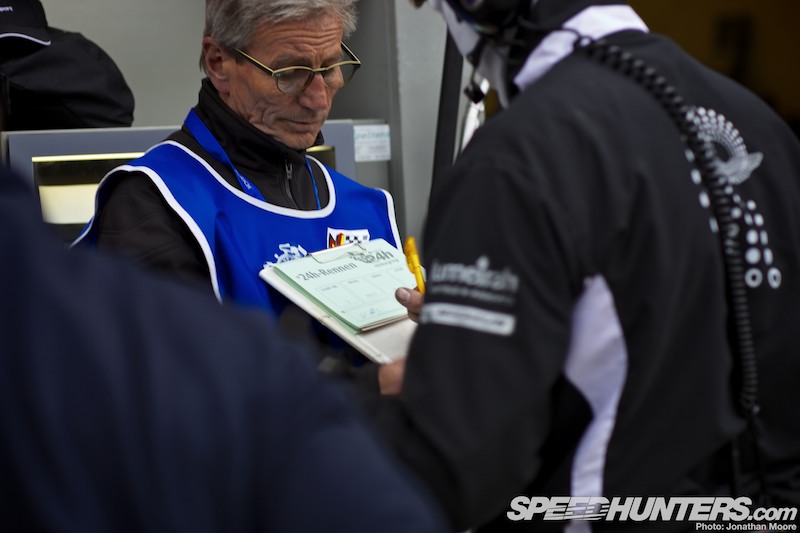
After every stop the team would have to sign off with the attending N24 ADAC official: sometimes it seemed a difficult enough task to track down the official in the crush of people…
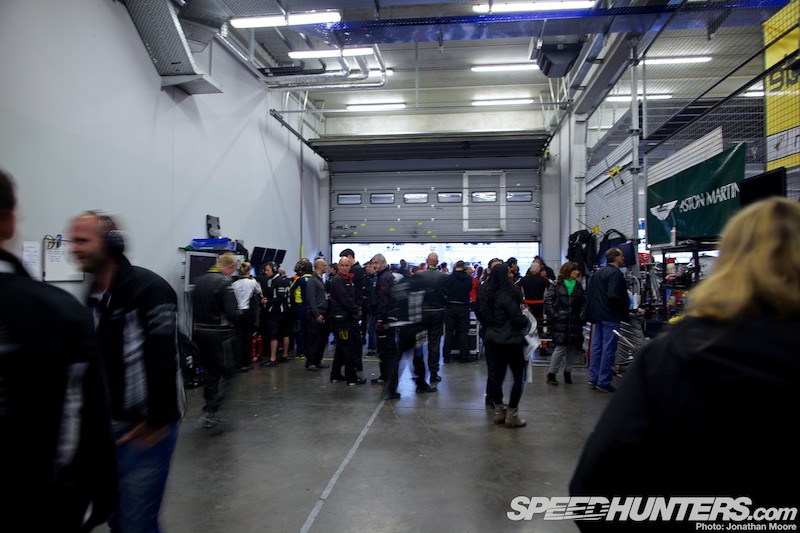
But for the first time in the weekend you could actually see some floor in the garages!
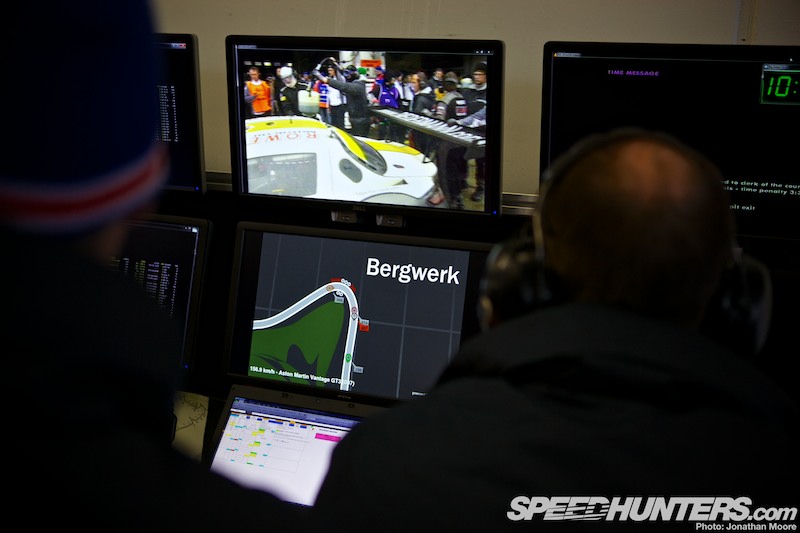
Whilst mechanics ran back and forward to the support trucks and guests milled around, the strategy team remained glued to their banks of monitors: timing and data screens, live TV feeds and then the all important large-scale GPS track, which showed the exact position of the cars around the track.
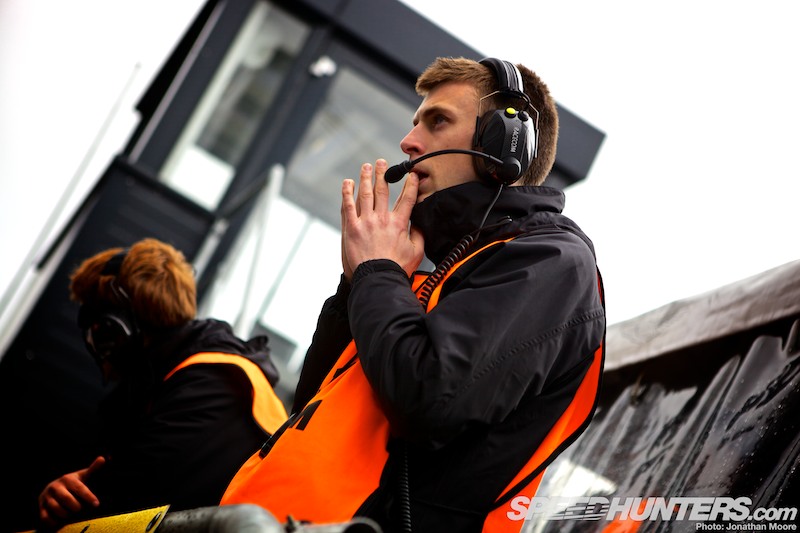
Out on the wall, only a set number of designated team members were allowed into the lines of tents huddled together on the pit wall like a high-tech shanty town: they would look on as the cars stopped behind them and the mechanics went to work.
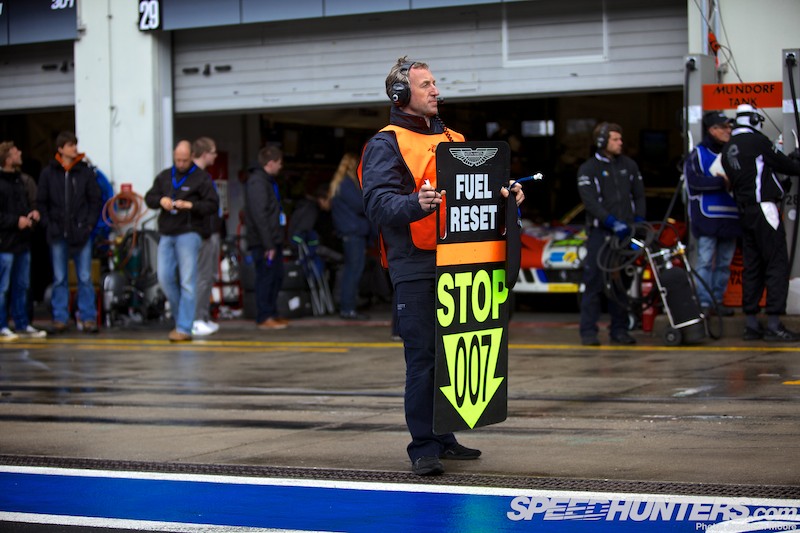
As each car was called in, a signaller would venture out to mark the stop for the incoming car.
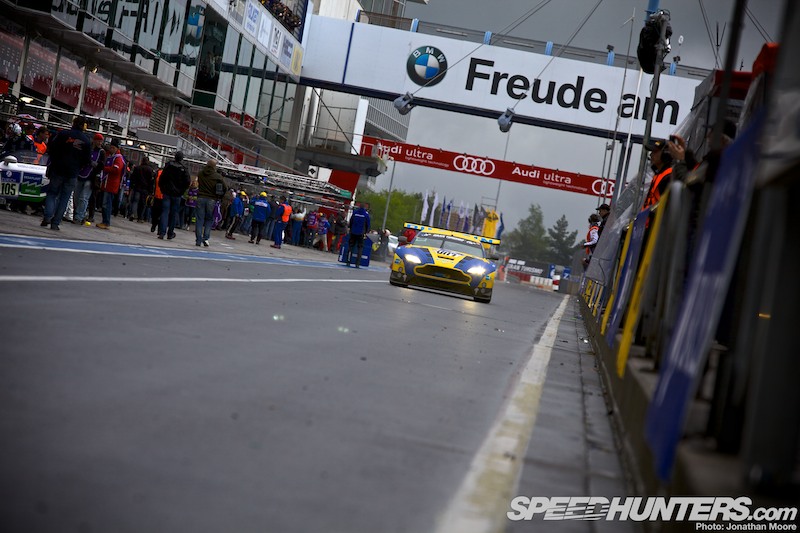
At the other end of the pit lane the hooter would sound to warn of an incoming car (a sound so frequent that it’s virtually constant) and the car would cruise down the pit lane on the limiter…
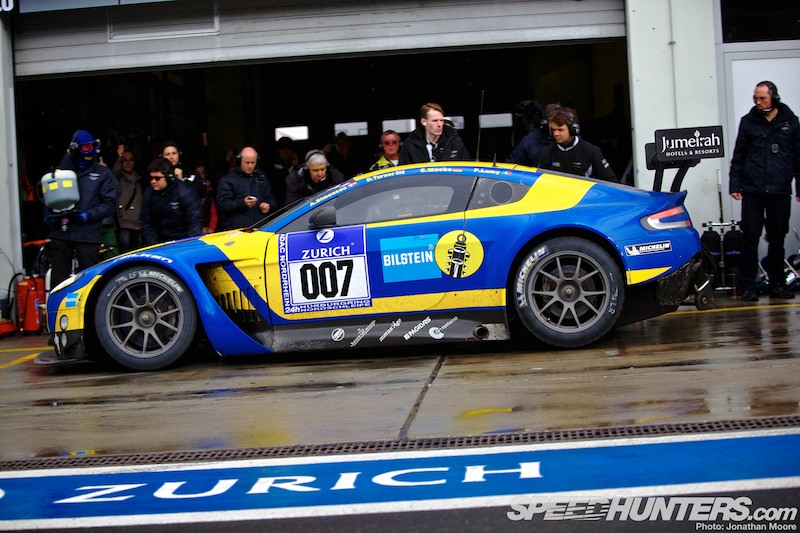
… and into the hands of the waiting team.
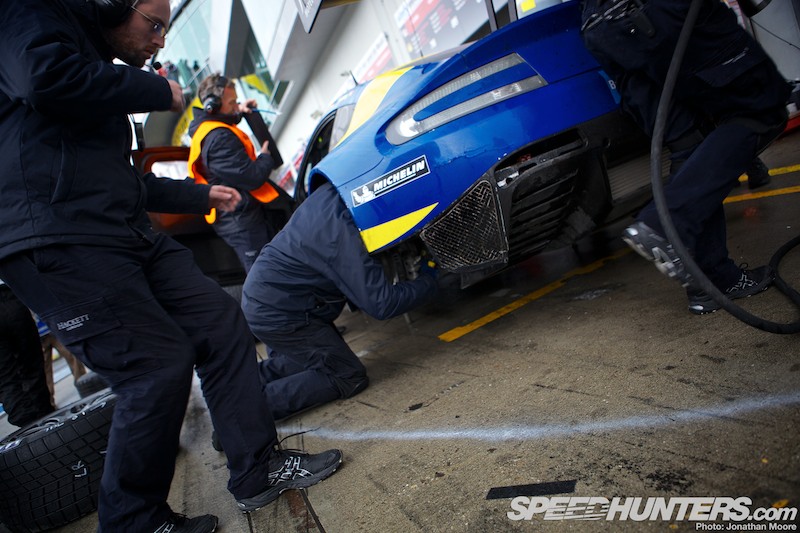
Sometimes you really need to get stuck in… Pedro continued for two stints in #007 before heading over to Allan Simonsen; the Vantage dropped to fourth, but Allan immediately started to close on the cars ahead. From fourth to third, from third to second…
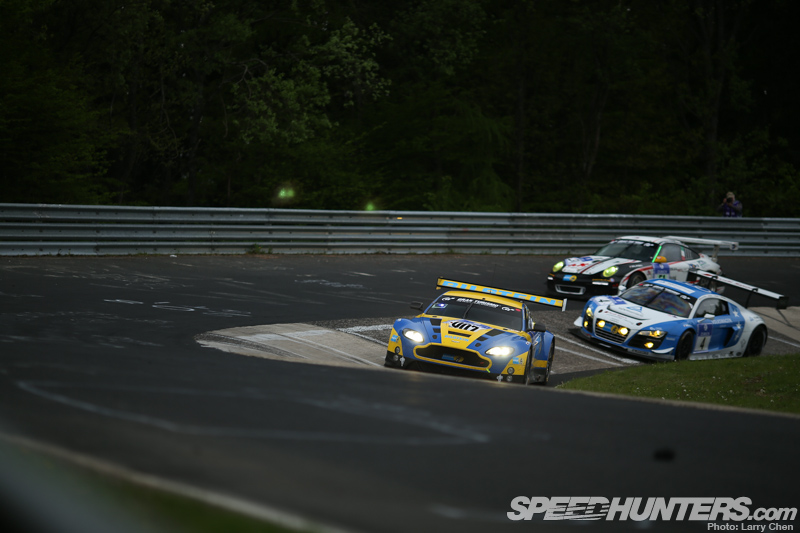
Come 19:00 #007 was back up to the tail of the leading Audi after taking five seconds out of the lead in one lap alone: Simonsen battled his way round and at 19:07 the timing screens reflected the change: Aston Martin led the Nürburgring 24 Hours!
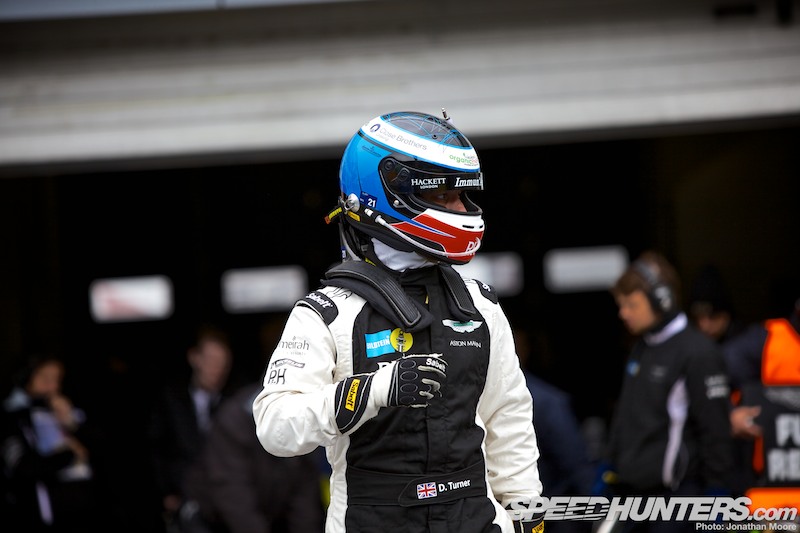
The light was beginning to fade, and with it the clouds got even more ominous. Darren Turner took over #007 from the lead, losing a couple of places whilst in the pits, but within 20 minutes the striking pace of the Vantage took Darren back into the lead of the race.
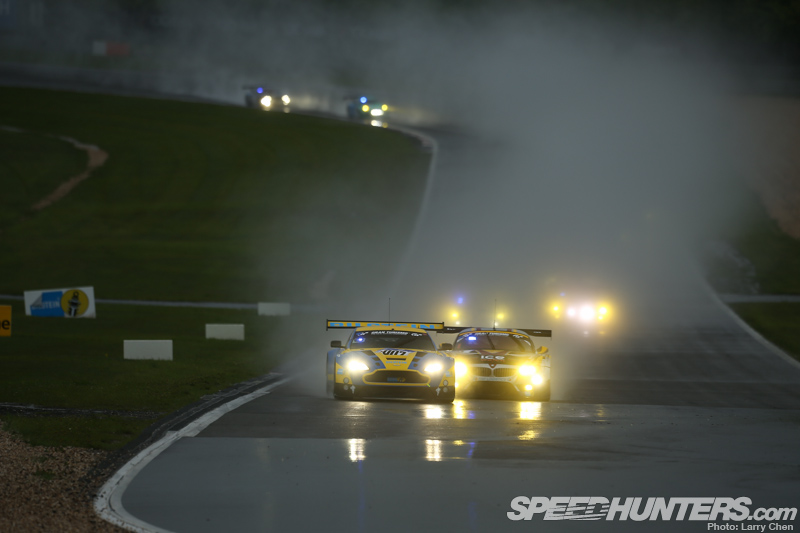
Stefan Mücke was next in the car, around three and half hours in, with #007 still leading, but half an hour into his stint the rain started falling – and falling hard.

He pitted early for wets and came back out with a 30 second lead, but the conditions just got worse and worse as darkness fell.
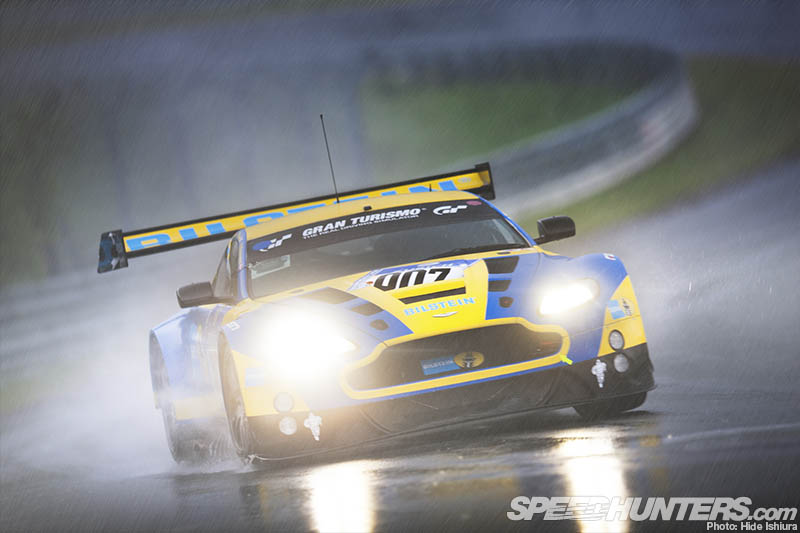
It was inevitable that the race would have to be stopped; even the most hardy driver would admit that the conditions were simply too dangerous to continue, especially with so many cars and drivers in the race. At 22:52 the red flag was shown.

The race order was reset to the end of the previous lap, lap 32, keeping #007 in first for whenever the race would be restarted. Which would be when?
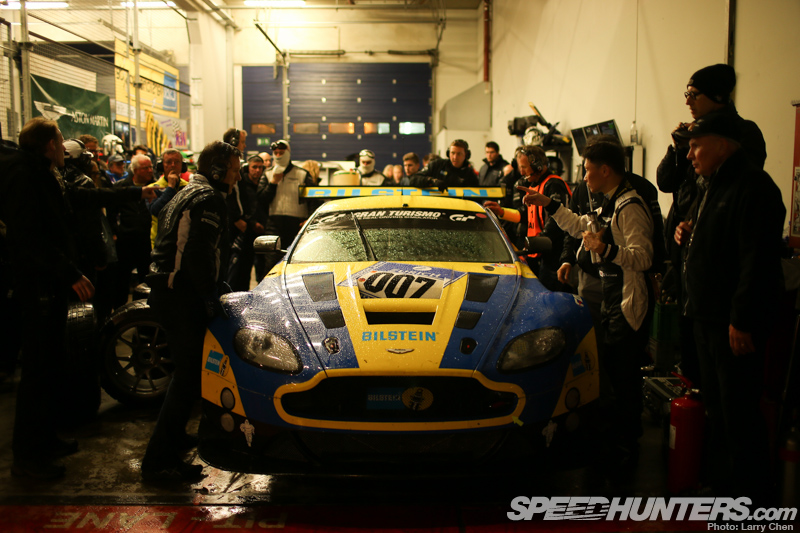
The hours ticked by with no sign of the rain relenting. But at least the cars weren’t under parc fermé conditions, so teams could work on damage and any other issues. #005 had been suffering from electrical problems, so the AM team spent the break hard at work. It was clear that the race wouldn’t be restarted until dawn, and so it proved. As the shrouded sun began to bring some light to the grey, it was announced that the race would restart at 08:05.

Pedro was strapped back into #007 and headed the field round for a warm-up lap before going racing again. The green flag flew at 8:20am, but all wasn’t well with #007. The pace of the previous day seemed to have disappeared along with the sun, and now #007 was eaten up by those behind.

An hour in and the rain and fog were back again, exacerbating #007’s woes: the car was struggling to get heat into its Michelins and therefore losing temperature and grip. The advantage from the previous evening was gone, so the team decided to go into fuel-saving mode to reduce time lost in pits in an effort to keep up with the leaders.
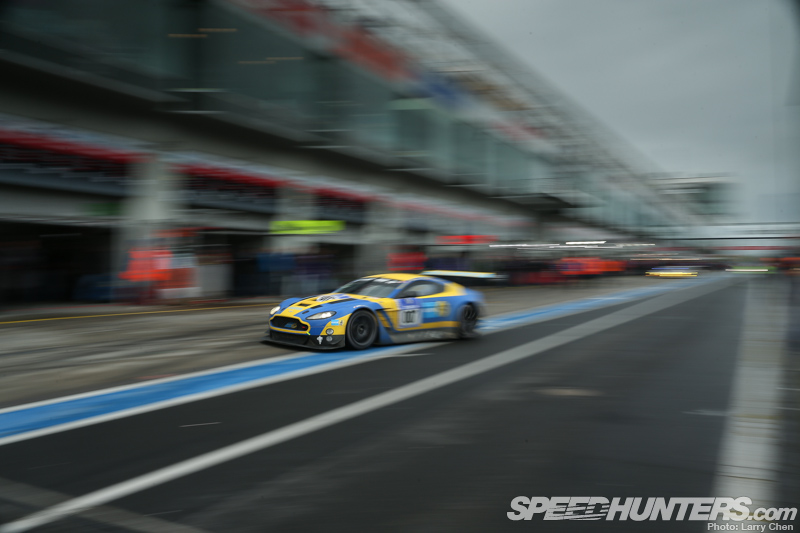
A light glancing blow off the barriers for #007 at around 10am proved that the grip troubles weren’t going away. The Vantage would be forced into preservation mode; finishing strongly would now be the target, and being ready to take advantage of any trouble for cars ahead.
Further down the field, the Rapide continued to deliver hydrogen-only laps, sticking to its plan of at least one pure lap per stint. #005 was recovering and performing strongly, but realistically too far back to be able to make it to the SP8 class podium. With four hours to go, the rumbling Merc SLSs were to the fore and looking like controlling the now dry race with the length of a regular VLN race to go. All four Astons continued to circulate, each still looking strong.
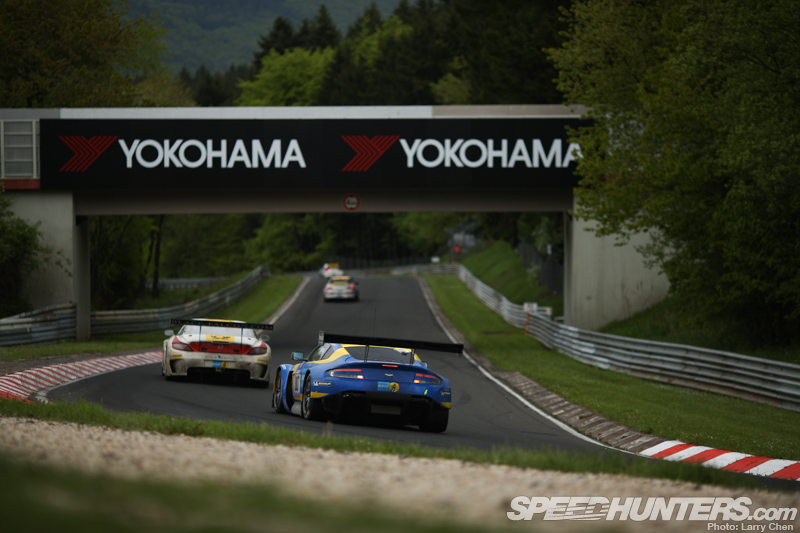
#007 was now in the top 10 and focusing on finishing the race in at least that position. The rain had stopped and sun was now drying the track, allowing the Aston to pick up some pace: #007 put in some of the fastest race laps during this period. Up front the battle had turned to see if the Mercs could hold off the charging Marc VDS Z4, which cut through the ROWE Racing SLSs to claim second, but couldn’t catch the Black Falcon Merc in first. #007 crossed the line in a fine 10th place: maybe not the podium they had hoped for, but still a great result in the face of such challenging conditions and enormously strong manufacturer-backed opposition.
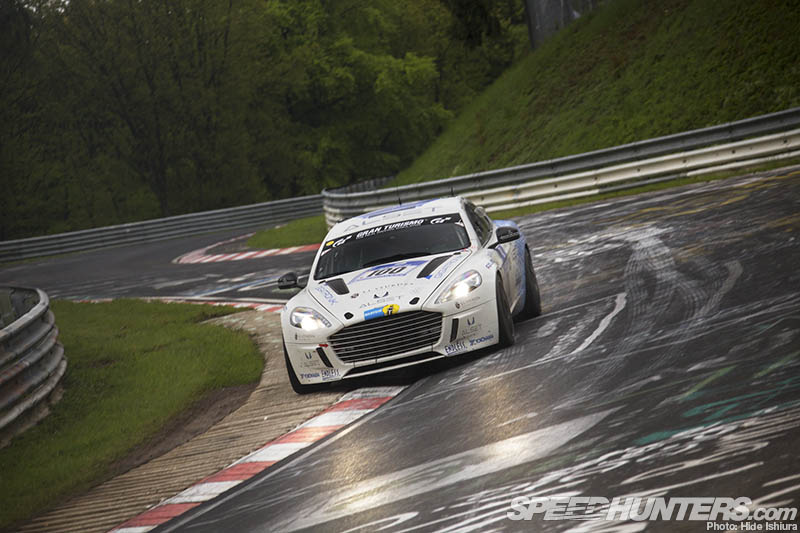
A strong and steady run netted the Rapide S a historic finish.
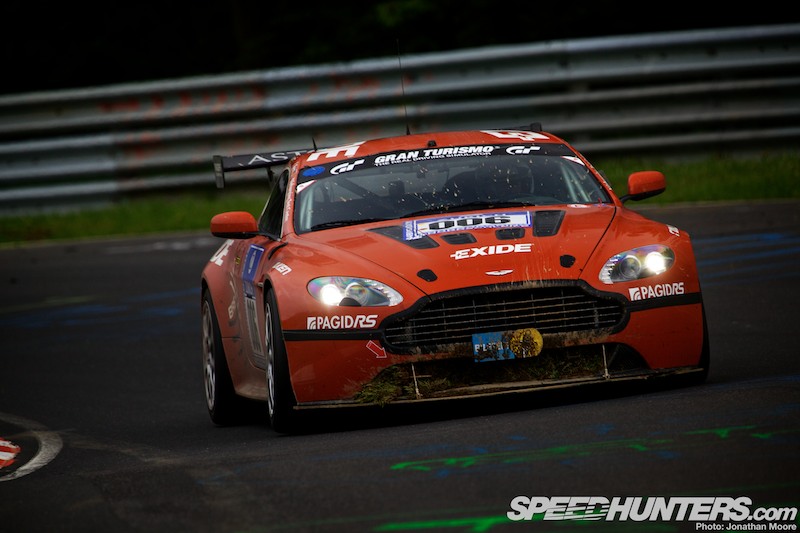
Similarly, the two Vantages were brought home, with #006 third in SP8 to deliver a podium finish – and another 100 percent finishing record for Aston Martin.
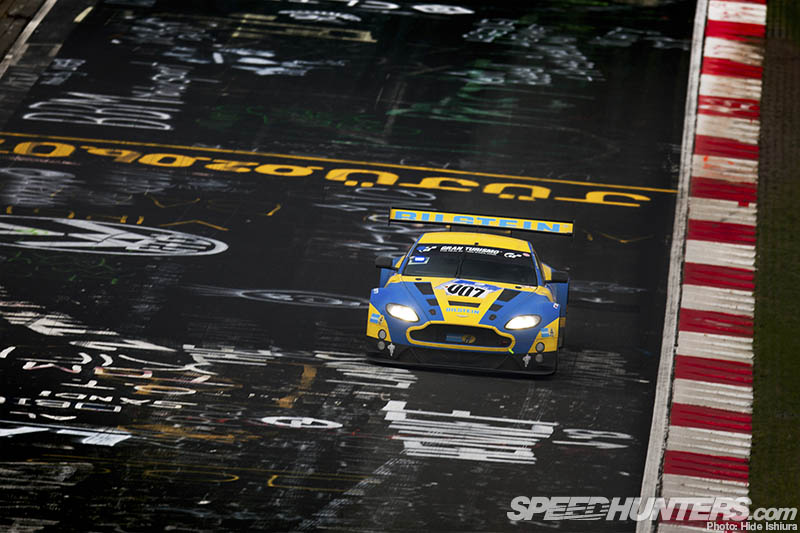
Aston Martin’s attention now turns to the next big endurance race, and June’s Le Mans 24 Hours, where we’re likely to see another epic GT battle – though I think we’re all hoping that it’s in far less challenging conditions…
Aston Martin at the 2013 Nürburgring 24 Hours
SP9 9th: #007 Aston Martin Vantage GT3 – 86 laps (10th overall)
SP8 3rd: #006 V8 Vantage – 71 laps (74th overall)
SP8 5th: #005 V12 Vantage – 66 laps (103rd overall)
E1-XP2 1st: Rapide S – 61 laps (112th overall)
Words and photos by Jonathan Moore
Instagram: speedhunters_jonathan
jonathan@speedhunters.com
Photos by Larry Chen
Instagram: larry_chen_foto
larry@speedhunters.com
Photos by Hide Ishiura
More Nürburgring 24 Hour ’13 coverage on Speedhunters
All Nürburgring coverage on Speedhunters

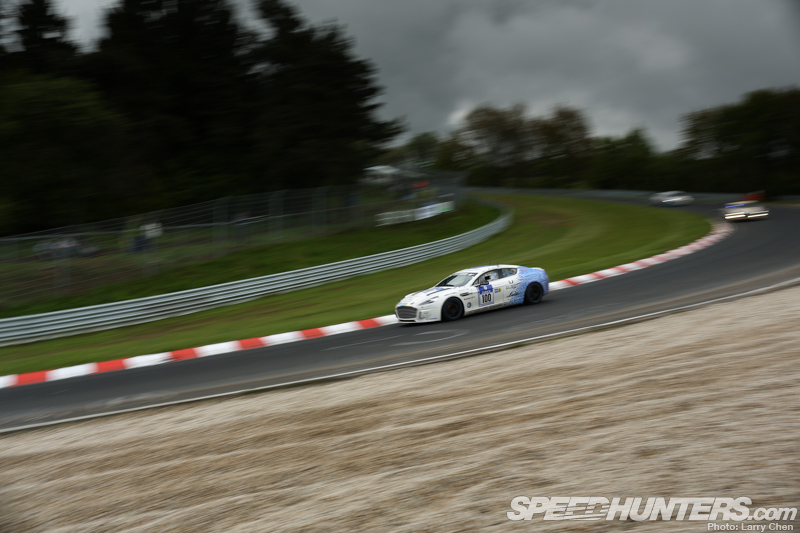














Is that a L motor on the title picture?